Kinematics modeling analysis of the geostationary satellite monitoring antenna system
The trend of scientific development in the future cannot fail to mention the great influence of the
space field, but in the immediate future, the observational satellite systems are related to communication technology. In fact, in some countries with strong development of communication technology and space technology, the mechanical system of geostationary satellite monitoring antennas
has certainly been thoroughly resolved. However, because of a specific technology, the sharing and
transferring of design and manufacturing technology to developing countries is a great challenge.
It is almost difficult to find published works related to mechanical design calculation and manufacture of geostationary satellite monitoring antenna systems. The problem of proactive grasping of
technology, step by step autonomy in manufacturing technology of telecommunications equipment related to space technology has always been the goal of developing countries like Vietnam
to limit technology dependence, minimizing technology transfer costs, ensuring national security.
The first step in these problems is the autonomous construction of terrestrial transceivers such as
geostationary satellite monitoring antennas.
This paper presents the kinematics modeling analysis of the mechanical system of the geostationary satellite monitoring antenna. Each component of the antenna system is assumed a rigid
body. The mathematical model is built based on multi-bodies kinematics and dynamics theory.
The DENAVIT-HARTENBERG (D-H) homogeneous matrix method was used to construct the kinematics equations. The forward kinematics problem is analyzed to determine the position, velocity,
acceleration, and workspace of the antenna system with given system motion limits. The inverse
kinematics problem is mentioned to determine the kinematics behaviors of the antenna system
with a given motion path in the workspace. The numerical simulation results kinematics were successfully applied in practice, especially for dynamics and control system analysis of geostationary
satellite antenna systems
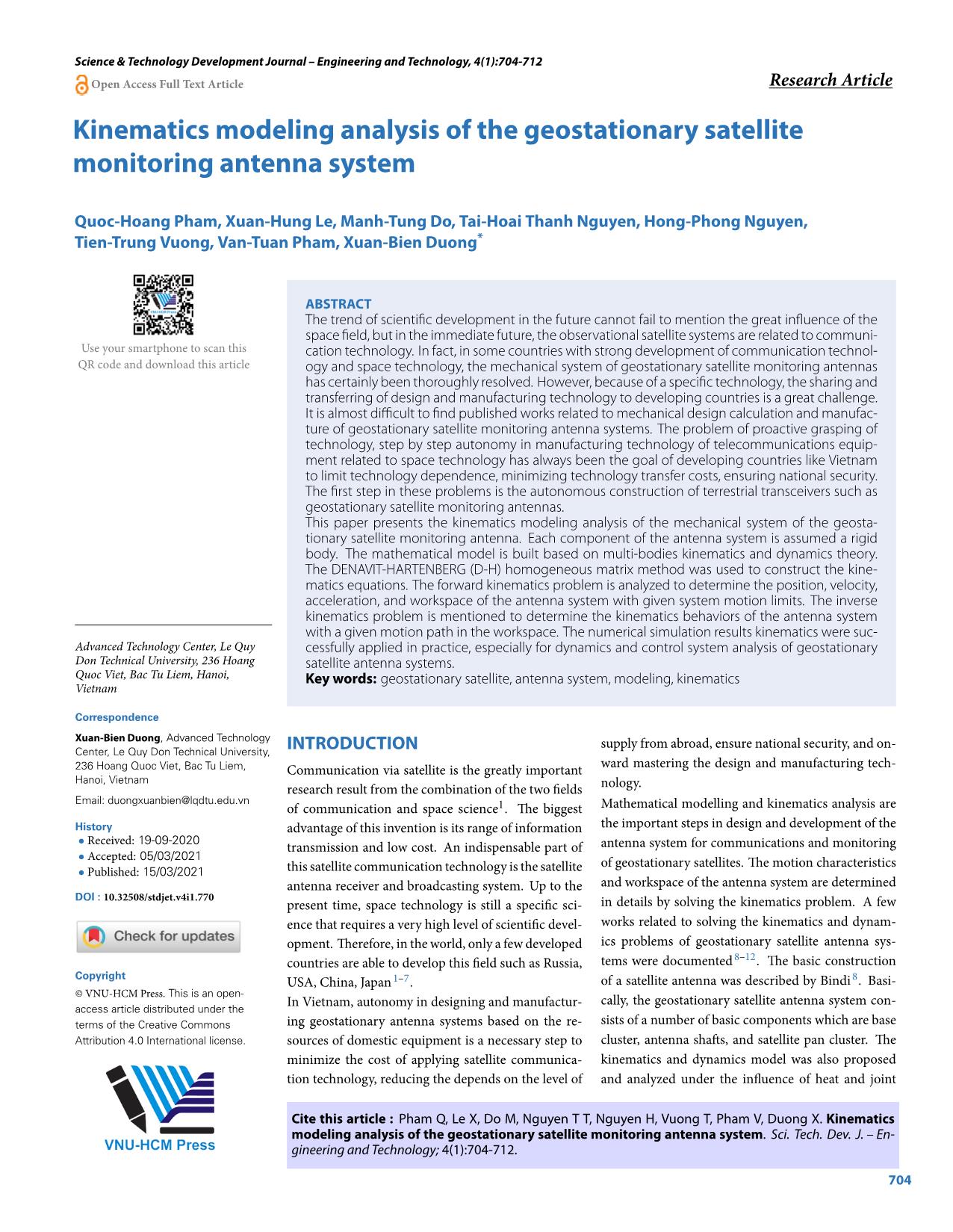
Trang 1
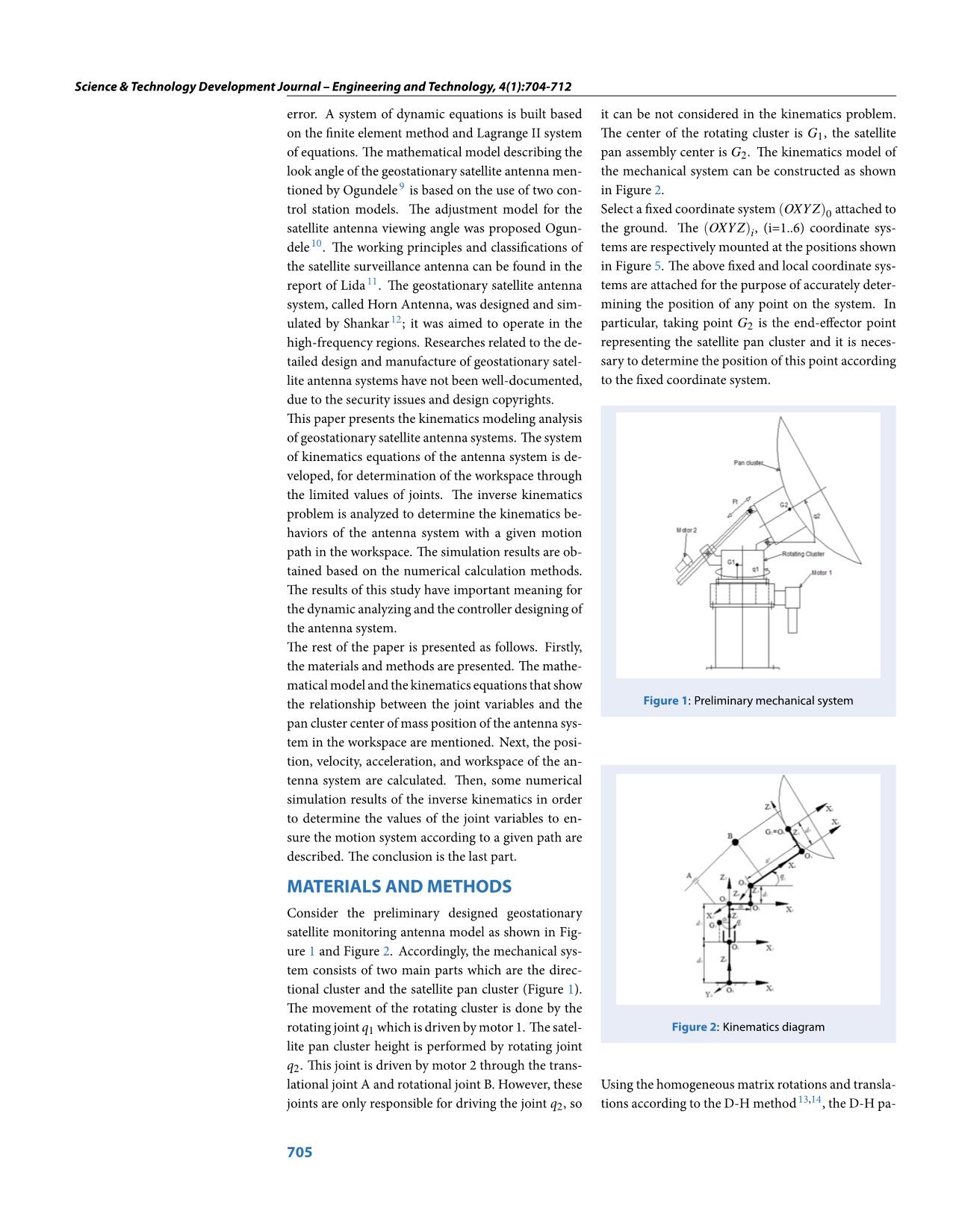
Trang 2
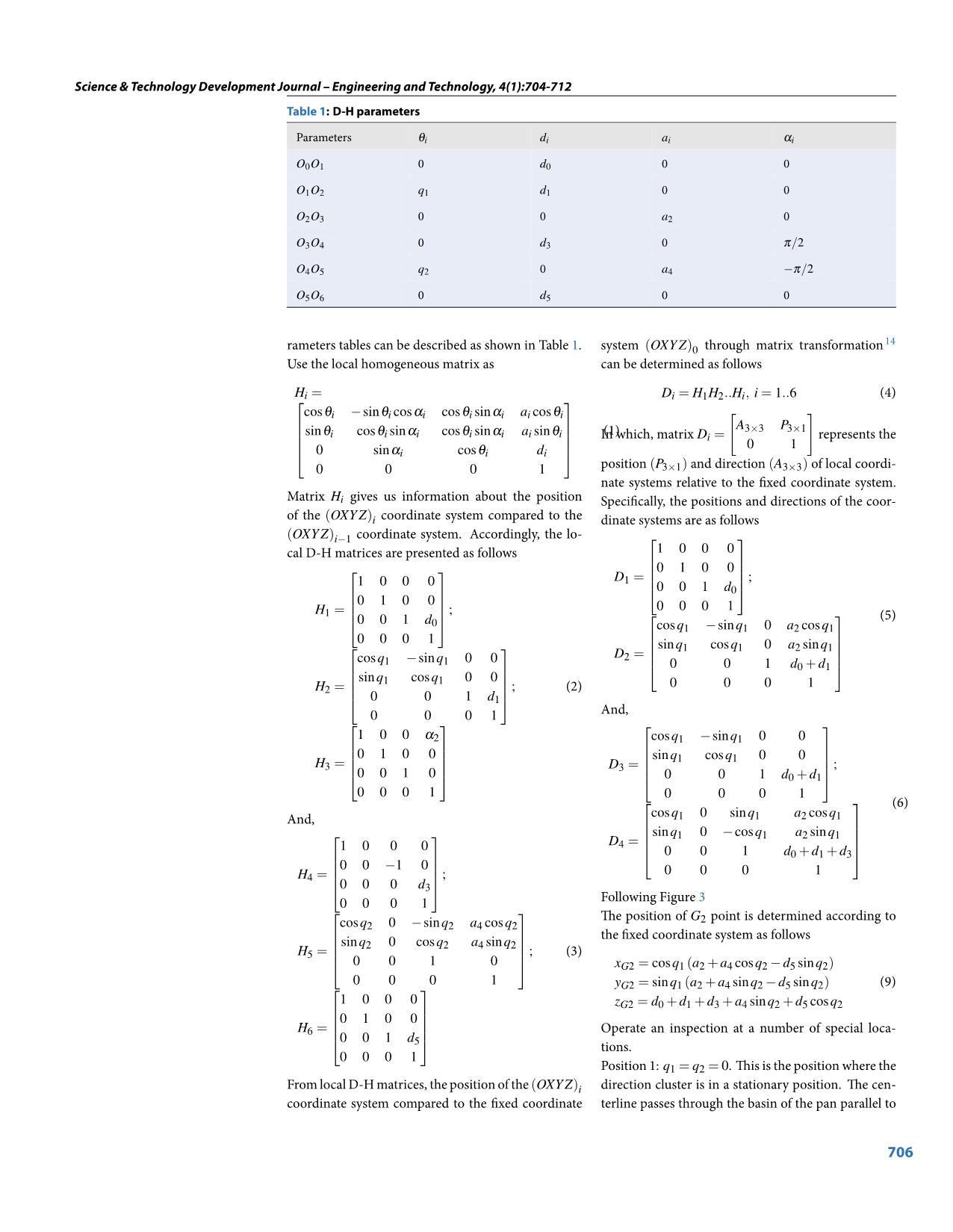
Trang 3
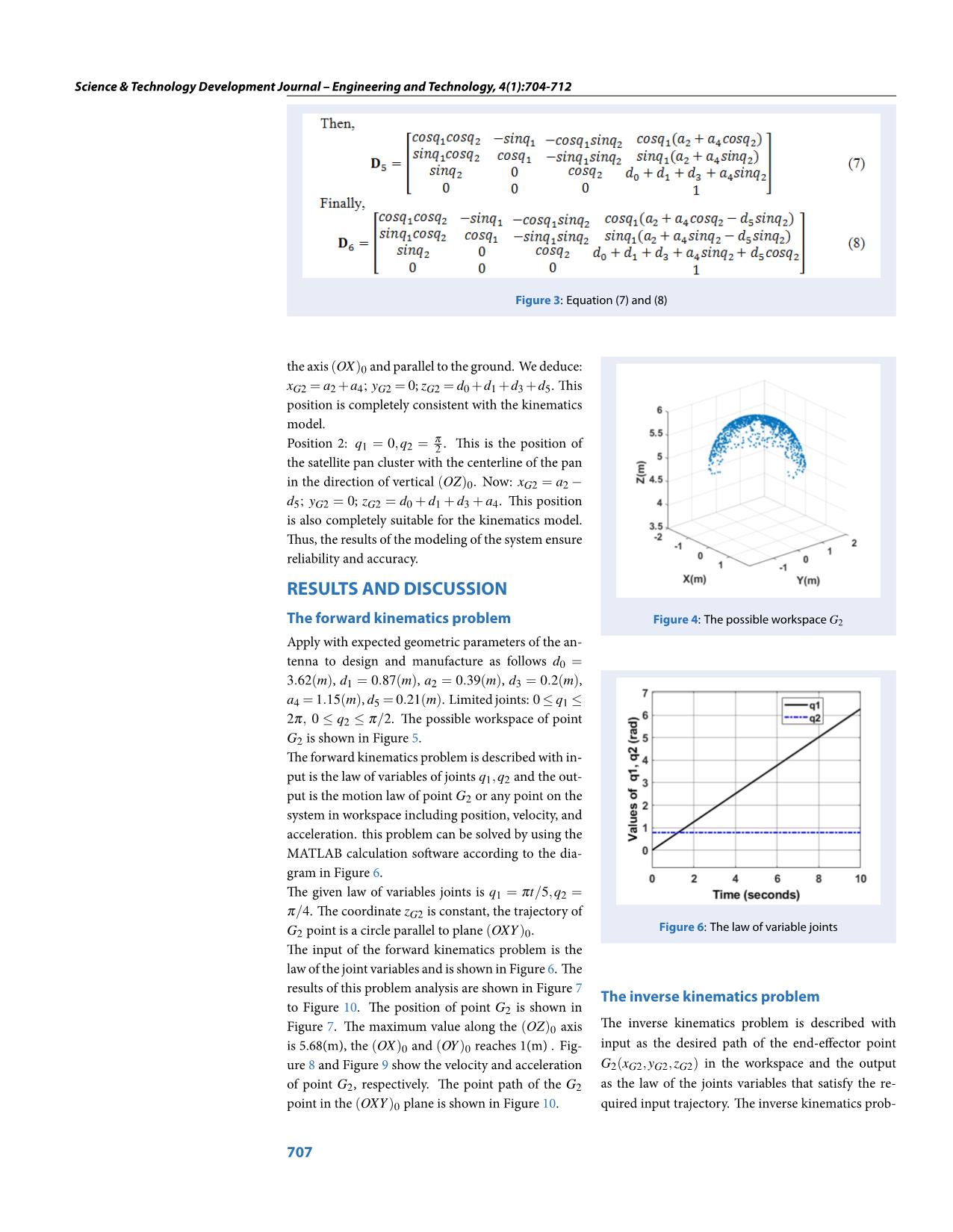
Trang 4
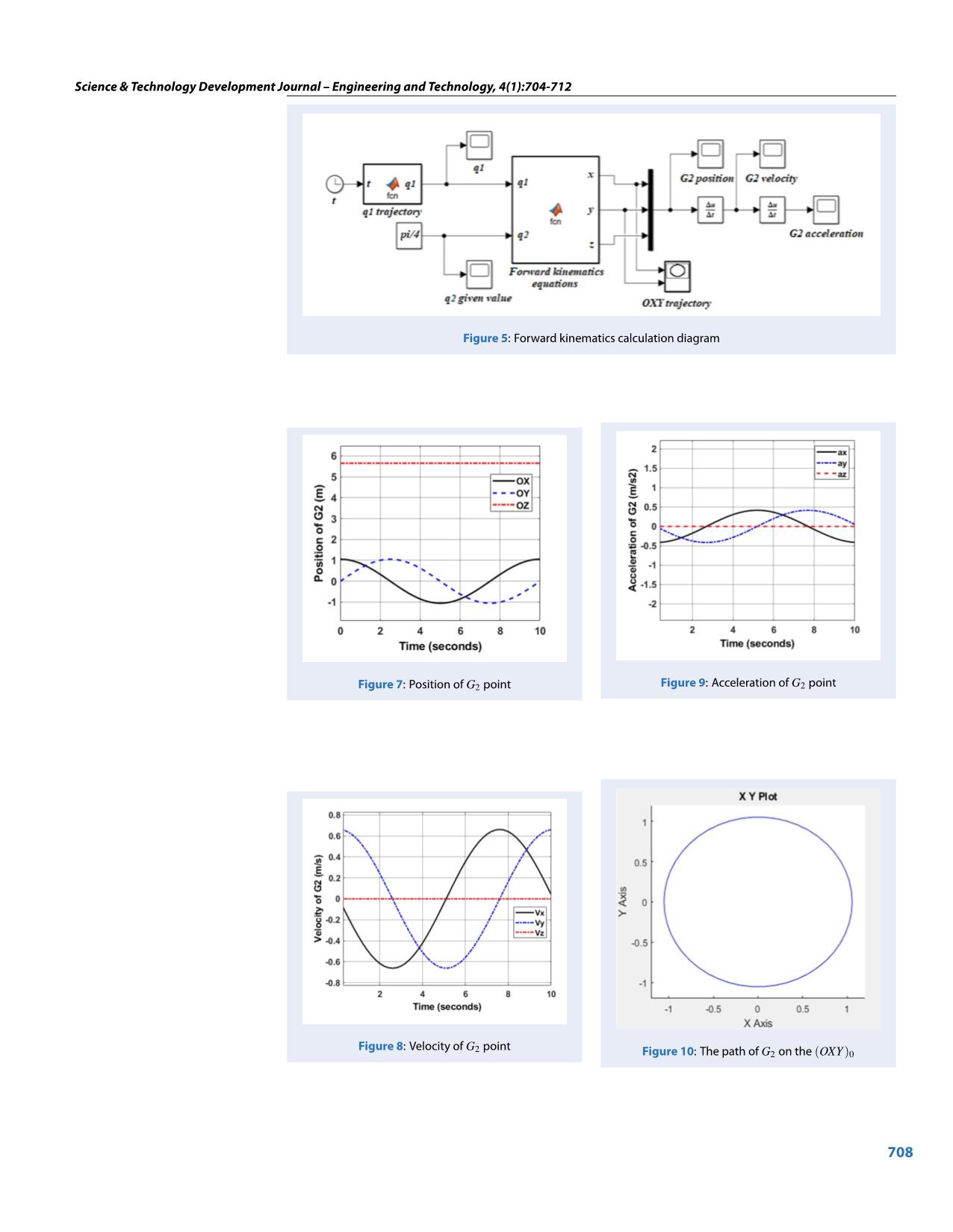
Trang 5
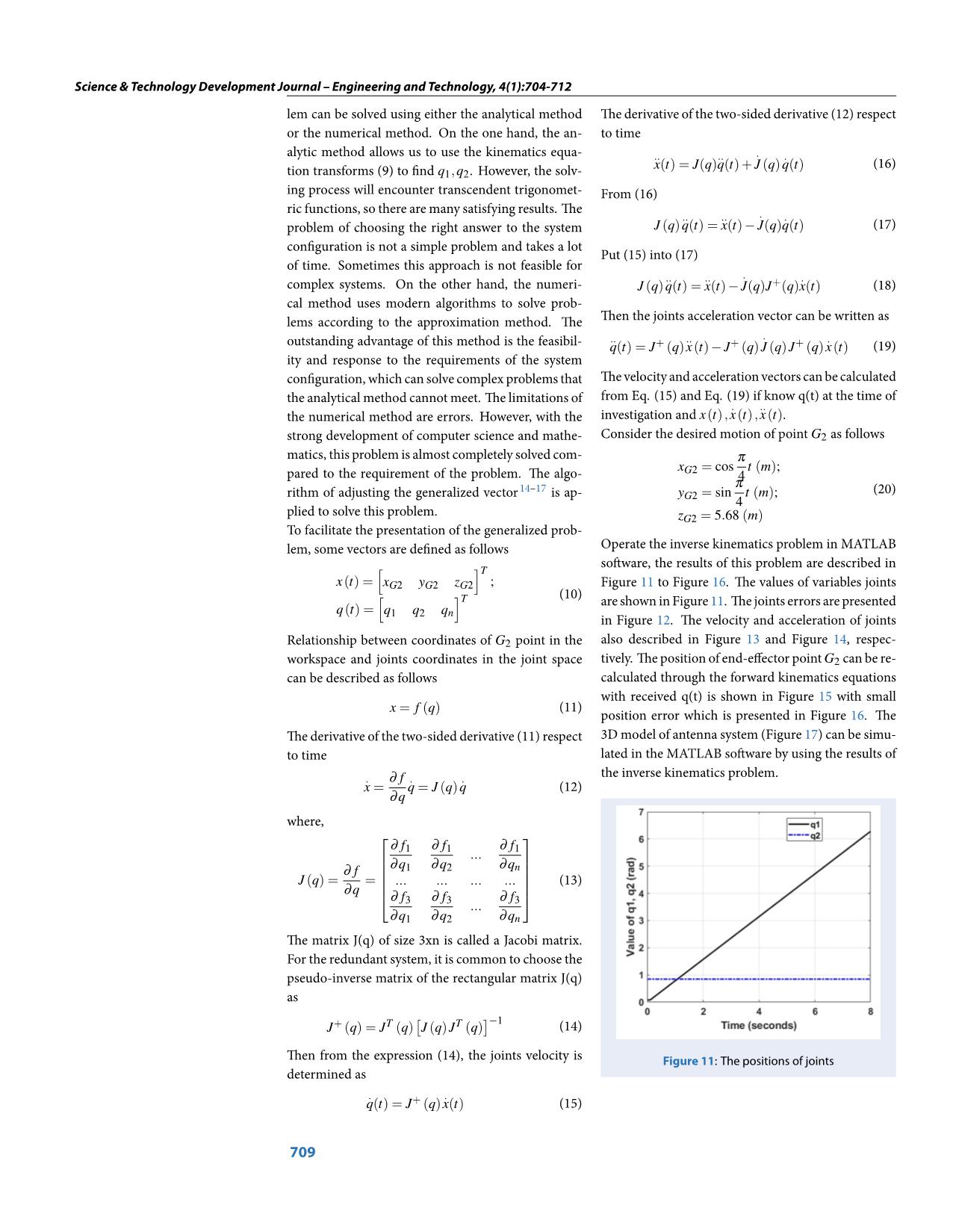
Trang 6
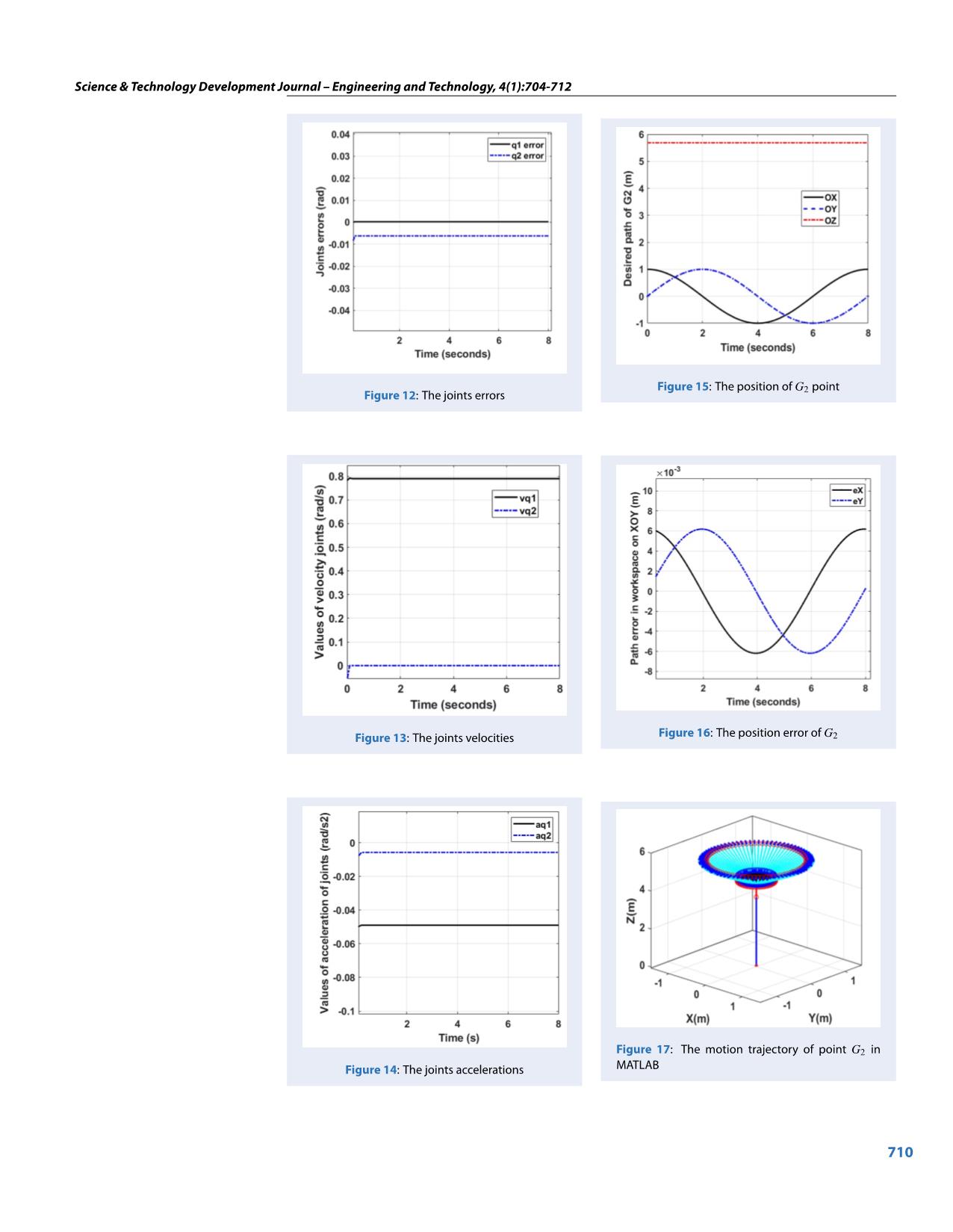
Trang 7
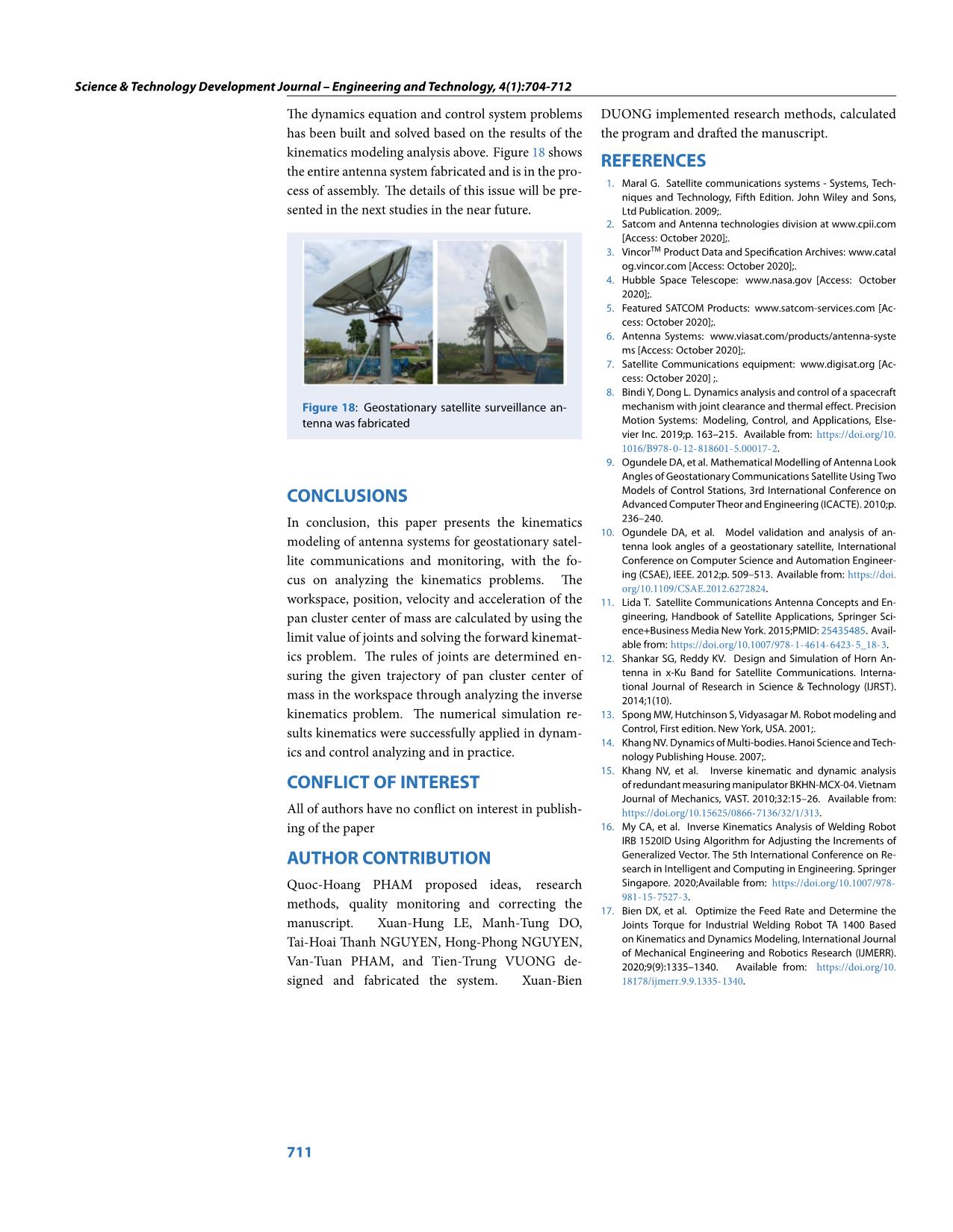
Trang 8
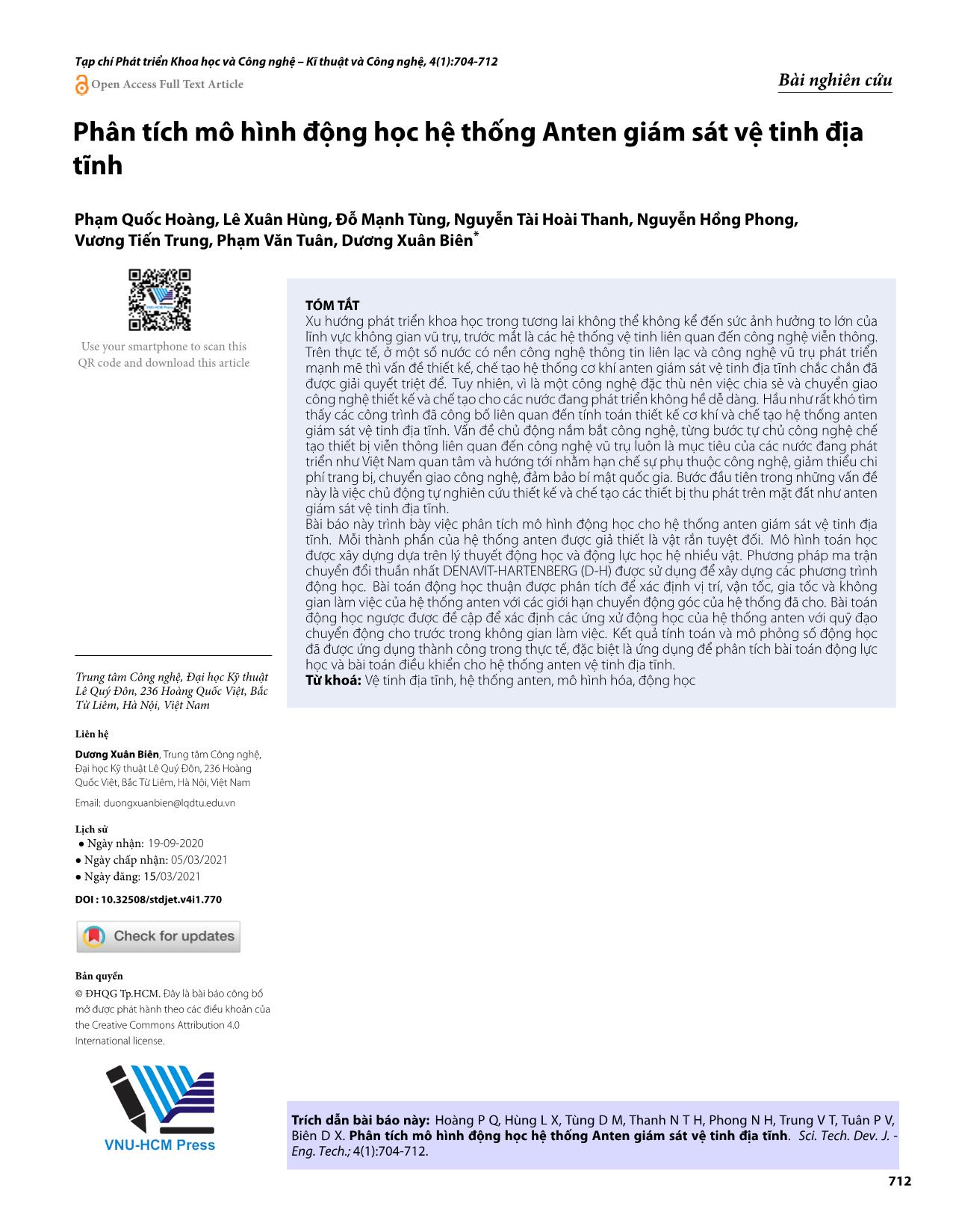
Trang 9
Tóm tắt nội dung tài liệu: Kinematics modeling analysis of the geostationary satellite monitoring antenna system
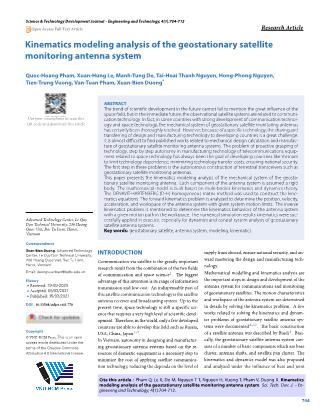
d cosq G2 0 1 3 4 2 5 2 0 1 0 0 H = Operate an inspection at a number of special loca- 6 0 0 1 d 5 tions. 0 0 0 1 Position 1: q1 = q2 = 0. This is the position where the From local D-H matrices, the position of the (OXYZ)i direction cluster is in a stationary position. The cen- coordinate system compared to the fixed coordinate terline passes through the basin of the pan parallel to 706 Science & Technology Development Journal – Engineering and Technology, 4(1):704-712 Figure 3: Equation (7) and (8) the axis (OX)0 and parallel to the ground. We deduce: xG2 = a2 +a4; yG2 = 0; zG2 = d0 +d1 +d3 +d5. This position is completely consistent with the kinematics model. π Position 2: q1 = 0,q2 = 2 . This is the position of the satellite pan cluster with the centerline of the pan in the direction of vertical (OZ)0. Now: xG2 = a2 − d5; yG2 = 0; zG2 = d0 + d1 + d3 + a4. This position is also completely suitable for the kinematics model. Thus, the results of the modeling of the system ensure reliability and accuracy. RESULTS AND DISCUSSION The forward kinematics problem Figure 4: The possible workspace G2 Apply with expected geometric parameters of the an- tenna to design and manufacture as follows d0 = 3.62(m), d1 = 0.87(m), a2 = 0.39(m), d3 = 0.2(m), a4 = 1.15(m), d5 = 0.21(m). Limited joints: 0 ≤ q1 ≤ 2π, 0 ≤ q2 ≤ π/2. The possible workspace of point G2 is shown in Figure 5. The forward kinematics problem is described with in- put is the law of variables of joints q1,q2 and the out- put is the motion law of point G2 or any point on the system in workspace including position, velocity, and acceleration. this problem can be solved by using the MATLAB calculation software according to the dia- gram in Figure 6. The given law of variables joints is q1 = πt/5,q2 = π/4. The coordinate zG2 is constant, the trajectory of G2 point is a circle parallel to plane (OXY)0. Figure 6: The law of variable joints The input of the forward kinematics problem is the law of the joint variables and is shown in Figure 6. The results of this problem analysis are shown in Figure 7 The inverse kinematics problem to Figure 10. The position of point G2 is shown in Figure 7. The maximum value along the (OZ)0 axis The inverse kinematics problem is described with is 5.68(m), the (OX)0 and (OY)0 reaches 1(m) . Fig- input as the desired path of the end-effector point ure 8 and Figure 9 show the velocity and acceleration G2(xG2,yG2,zG2) in the workspace and the output of point G2, respectively. The point path of the G2 as the law of the joints variables that satisfy the re- point in the (OXY)0 plane is shown in Figure 10. quired input trajectory. The inverse kinematics prob- 707 Science & Technology Development Journal – Engineering and Technology, 4(1):704-712 Figure 5: Forward kinematics calculation diagram Figure 7: Position of G2 point Figure 9: Acceleration of G2 point Figure 8: Velocity of G2 point Figure 10: The path of G2 on the (OXY)0 708 Science & Technology Development Journal – Engineering and Technology, 4(1):704-712 lem can be solved using either the analytical method The derivative of the two-sided derivative (12) respect or the numerical method. On the one hand, the an- to time alytic method allows us to use the kinematics equa- .. .. . . x(t) = J(q)q(t) + J (q)q(t) (16) tion transforms (9) to find q1,q2. However, the solv- ing process will encounter transcendent trigonomet- From (16) ric functions, so there are many satisfying results. The .. .. . . problem of choosing the right answer to the system J (q)q(t) = x(t) − J(q)q(t) (17) configuration is not a simple problem and takes a lot Put (15) into (17) of time. Sometimes this approach is not feasible for .. .. . . complex systems. On the other hand, the numeri- J (q)q(t) = x(t) − J(q)J+(q)x(t) (18) cal method uses modern algorithms to solve prob- lems according to the approximation method. The Then the joints acceleration vector can be written as .. .. . . outstanding advantage of this method is the feasibil- q(t) = J+ (q)x(t) − J+ (q)J (q)J+ (q)x(t) (19) ity and response to the requirements of the system configuration, which can solve complex problems that The velocity and acceleration vectors can be calculated the analytical method cannot meet. The limitations of from Eq. (15) and Eq. (19) if know q(t) at the time of . .. the numerical method are errors. However, with the investigation and x(t),x(t),x(t). strong development of computer science and mathe- Consider the desired motion of point G2 as follows matics, this problem is almost completely solved com- π xG2 = cos t (m); pared to the requirement of the problem. The algo- π4 rithm of adjusting the generalized vector 14–17 is ap- y = sin t (m); (20) G2 4 plied to solve this problem. zG2 = 5.68 (m) To facilitate the presentation of the generalized prob- lem, some vectors are defined as follows Operate the inverse kinematics problem in MATLAB [ ] T software, the results of this problem are described in x(t) = xG2 yG2 zG2 ; Figure 11 to Figure 16. The values of variables joints [ ] (10) T are shown in Figure 11. The joints errors are presented q(t) = q1 q2 qn in Figure 12. The velocity and acceleration of joints Relationship between coordinates of G2 point in the also described in Figure 13 and Figure 14, respec- workspace and joints coordinates in the joint space tively. The position of end-effector point G2 can be re- can be described as follows calculated through the forward kinematics equations with received q(t) is shown in Figure 15 with small x = f (q) (11) position error which is presented in Figure 16. The The derivative of the two-sided derivative (11) respect 3D model of antenna system (Figure 17) can be simu- to time lated in the MATLAB software by using the results of . ∂ f . . the inverse kinematics problem. x = q = J (q)q (12) ∂q where, ∂ f1 ∂ f1 ∂ f1 ... ∂q ∂q ∂q ∂ f 1 2 n J (q) = ∂ = ... ... ... ... (13) q ∂ f ∂ f ∂ f 3 3 ... 3 ∂q1 ∂q2 ∂qn The matrix J(q) of size 3xn is called a Jacobi matrix. For the redundant system, it is common to choose the pseudo-inverse matrix of the rectangular matrix J(q) as [ ]− J+ (q) = JT (q) J (q)JT (q) 1 (14) Then from the expression (14), the joints velocity is Figure 11: The positions of joints determined as . . q(t) = J+ (q)x(t) (15) 709 Science & Technology Development Journal – Engineering and Technology, 4(1):704-712 Figure 15: The position of G2 point Figure 12: The joints errors Figure 13: The joints velocities Figure 16: The position error of G2 Figure 17: The motion trajectory of point G2 in Figure 14: The joints accelerations MATLAB 710 Science & Technology Development Journal – Engineering and Technology, 4(1):704-712 The dynamics equation and control system problems DUONG implemented research methods, calculated has been built and solved based on the results of the the program and drafted the manuscript. kinematics modeling analysis above. Figure 18 shows REFERENCES the entire antenna system fabricated and is in the pro- 1. Maral G. Satellite communications systems - Systems, Tech- cess of assembly. The details of this issue will be pre- niques and Technology, Fifth Edition. John Wiley and Sons, sented in the next studies in the near future. Ltd Publication. 2009;. 2. Satcom and Antenna technologies division at www.cpii.com [Access: October 2020];. 3. VincorTM Product Data and Specification Archives: www.catal og.vincor.com [Access: October 2020];. 4. Hubble Space Telescope: www.nasa.gov [Access: October 2020];. 5. Featured SATCOM Products: www.satcom-services.com [Ac- cess: October 2020];. 6. Antenna Systems: www.viasat.com/products/antenna-syste ms [Access: October 2020];. 7. Satellite Communications equipment: www.digisat.org [Ac- cess: October 2020] ;. 8. Bindi Y, Dong L. Dynamics analysis and control of a spacecraft Figure 18: Geostationary satellite surveillance an- mechanism with joint clearance and thermal effect. Precision tenna was fabricated Motion Systems: Modeling, Control, and Applications, Else- vier Inc. 2019;p. 163–215. Available from: https://doi.org/10. 1016/B978-0-12-818601-5.00017-2. 9. Ogundele DA, et al. Mathematical Modelling of Antenna Look Angles of Geostationary Communications Satellite Using Two Models of Control Stations, 3rd International Conference on CONCLUSIONS Advanced Computer Theor and Engineering (ICACTE). 2010;p. In conclusion, this paper presents the kinematics 236–240. 10. Ogundele DA, et al. Model validation and analysis of an- modeling of antenna systems for geostationary satel- tenna look angles of a geostationary satellite, International lite communications and monitoring, with the fo- Conference on Computer Science and Automation Engineer- cus on analyzing the kinematics problems. The ing (CSAE), IEEE. 2012;p. 509–513. Available from: https://doi. org/10.1109/CSAE.2012.6272824. workspace, position, velocity and acceleration of the 11. Lida T. Satellite Communications Antenna Concepts and En- pan cluster center of mass are calculated by using the gineering, Handbook of Satellite Applications, Springer Sci- ence+Business Media New York. 2015;PMID: 25435485. Avail- limit value of joints and solving the forward kinemat- able from: https://doi.org/10.1007/978-1-4614-6423-5_18-3. ics problem. The rules of joints are determined en- 12. Shankar SG, Reddy KV. Design and Simulation of Horn An- suring the given trajectory of pan cluster center of tenna in x-Ku Band for Satellite Communications. Interna- tional Journal of Research in Science & Technology (IJRST). mass in the workspace through analyzing the inverse 2014;1(10). kinematics problem. The numerical simulation re- 13. Spong MW, Hutchinson S, Vidyasagar M. Robot modeling and sults kinematics were successfully applied in dynam- Control, First edition. New York, USA. 2001;. 14. Khang NV. Dynamics of Multi-bodies. Hanoi Science and Tech- ics and control analyzing and in practice. nology Publishing House. 2007;. 15. Khang NV, et al. Inverse kinematic and dynamic analysis CONFLICT OF INTEREST of redundant measuring manipulator BKHN-MCX-04. Vietnam Journal of Mechanics, VAST. 2010;32:15–26. Available from: All of authors have no conflict on interest in publish- https://doi.org/10.15625/0866-7136/32/1/313. ing of the paper 16. My CA, et al. Inverse Kinematics Analysis of Welding Robot IRB 1520ID Using Algorithm for Adjusting the Increments of AUTHOR CONTRIBUTION Generalized Vector. The 5th International Conference on Re- search in Intelligent and Computing in Engineering. Springer Quoc-Hoang PHAM proposed ideas, research Singapore. 2020;Available from: https://doi.org/10.1007/978- 981-15-7527-3. methods, quality monitoring and correcting the 17. Bien DX, et al. Optimize the Feed Rate and Determine the manuscript. Xuan-Hung LE, Manh-Tung DO, Joints Torque for Industrial Welding Robot TA 1400 Based Tai-Hoai Thanh NGUYEN, Hong-Phong NGUYEN, on Kinematics and Dynamics Modeling, International Journal of Mechanical Engineering and Robotics Research (IJMERR). Van-Tuan PHAM, and Tien-Trung VUONG de- 2020;9(9):1335–1340. Available from: https://doi.org/10. signed and fabricated the system. Xuan-Bien 18178/ijmerr.9.9.1335-1340. 711 Tạp chí Phát triển Khoa học và Công nghệ – Kĩ thuật và Công nghệ, 4(1):704-712 Open Access Full Text Article Bài nghiên cứu Phân tích mô hình động học hệ thống Anten giám sát vệ tinh địa tĩnh Phạm Quốc Hoàng, Lê Xuân Hùng, Đỗ Mạnh Tùng, Nguyễn Tài Hoài Thanh, Nguyễn Hồng Phong, Vương Tiến Trung, Phạm Văn Tuân, Dương Xuân Biên* TÓM TẮT Xu hướng phát triển khoa học trong tương lai không thể không kể đến sức ảnh hưởng to lớn của lĩnh vực không gian vũ trụ, trước mắt là các hệ thống vệ tinh liên quan đến công nghệ viễn thông. Use your smartphone to scan this Trên thực tế, ở một số nước có nền công nghệ thông tin liên lạc và công nghệ vũ trụ phát triển QR code and download this article mạnh mẽ thì vấn đề thiết kế, chế tạo hệ thống cơ khí anten giám sát vệ tinh địa tĩnh chắc chắn đã được giải quyết triệt để. Tuy nhiên, vì là một công nghệ đặc thù nên việc chia sẻ và chuyển giao công nghệ thiết kế và chế tạo cho các nước đang phát triển không hề dễ dàng. Hầu như rất khó tìm thấy các công trình đã công bố liên quan đến tính toán thiết kế cơ khí và chế tạo hệ thống anten giám sát vệ tinh địa tĩnh. Vấn đề chủ động nắm bắt công nghệ, từng bước tự chủ công nghệ chế tạo thiết bị viễn thông liên quan đến công nghệ vũ trụ luôn là mục tiêu của các nước đang phát triển như Việt Nam quan tâm và hướng tới nhằm hạn chế sự phụ thuộc công nghệ, giảm thiểu chi phí trang bị, chuyển giao công nghệ, đảm bảo bí mật quốc gia. Bước đầu tiên trong những vấn đề này là việc chủ động tự nghiên cứu thiết kế và chế tạo các thiết bị thu phát trên mặt đất như anten giám sát vệ tinh địa tĩnh. Bài báo này trình bày việc phân tích mô hình động học cho hệ thống anten giám sát vệ tinh địa tĩnh. Mỗi thành phần của hệ thống anten được giả thiết là vật rắn tuyệt đối. Mô hình toán học được xây dựng dựa trên lý thuyết động học và động lực học hệ nhiều vật. Phương pháp ma trận chuyển đổi thuần nhất DENAVIT-HARTENBERG (D-H) được sử dụng để xây dựng các phương trình động học. Bài toán động học thuận được phân tích để xác định vị trí, vận tốc, gia tốc và không gian làm việc của hệ thống anten với các giới hạn chuyển động góc của hệ thống đã cho. Bài toán động học ngược được đề cập để xác định các ứng xử động học của hệ thống anten với quỹ đạo chuyển động cho trước trong không gian làm việc. Kết quả tính toán và mô phỏng số động học đã được ứng dụng thành công trong thực tế, đặc biệt là ứng dụng để phân tích bài toán động lực học và bài toán điều khiển cho hệ thống anten vệ tinh địa tĩnh. Trung tâm Công nghệ, Đại học Kỹ thuật Từ khoá: Vệ tinh địa tĩnh, hệ thống anten, mô hình hóa, động học Lê Quý Đôn, 236 Hoàng Quốc Việt, Bắc Từ Liêm, Hà Nội, Việt Nam Liên hệ Dương Xuân Biên, Trung tâm Công nghệ, Đại học Kỹ thuật Lê Quý Đôn, 236 Hoàng Quốc Việt, Bắc Từ Liêm, Hà Nội, Việt Nam Email: duongxuanbien@lqdtu.edu.vn Lịch sử • Ngày nhận: 19-09-2020 • Ngày chấp nhận: 05/03/2021 • Ngày đăng: 15/03/2021 DOI : 10.32508/stdjet.v4i1.770 Bản quyền © ĐHQG Tp.HCM. Đây là bài báo công bố mở được phát hành theo các điều khoản của the Creative Commons Attribution 4.0 International license. Trích dẫn bài báo này: Hoàng P Q, Hùng L X, Tùng D M, Thanh N T H, Phong N H, Trung V T, Tuân P V, Biên D X. Phân tích mô hình động học hệ thống Anten giám sát vệ tinh địa tĩnh. Sci. Tech. Dev. J. - Eng. Tech.; 4(1):704-712. 712
File đính kèm:
 kinematics_modeling_analysis_of_the_geostationary_satellite.pdf
kinematics_modeling_analysis_of_the_geostationary_satellite.pdf

